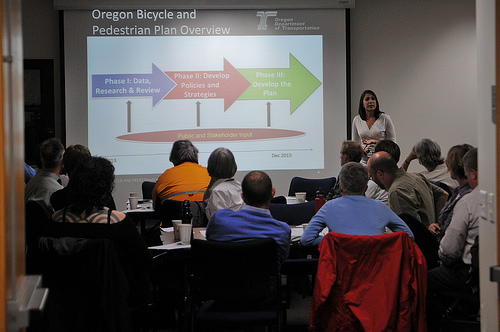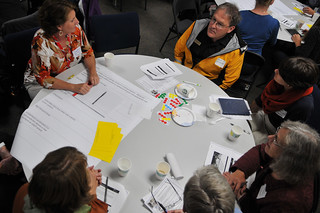
The Oregon Department of Transportation (ODOT) hosted a “listening session” at their Portland regional headquarters yesterday. It was the fifth of five such meetings they’re using to gather insights and learn key issues they should address in a major update to their Bicycle and Pedestrian Mode Plan.
ODOT’s existing plan for setting statewide policy around bicycling and walking was adopted way back in 1995.
At Wednesday’s meeting, ODOT heard from about 75 experts, agency staffers, advocates, and volunteer activists. Faces in the crowd included: Blaine Meier, owner of First City Cycles in Oregon City; Lake McTighe, Metro active transportation planner; Roger Geller, PBOT bicycle coordinator; Jeff Owen, Trimet active transportation planner; Margi Bradway, PBOT Active Transportation Division manager; Cory Poole, NW Skate Coalition; Jim Parsons, Beaverton resident and bike activist; Sheila Lyons, ODOT Bicycle and Pedestrian Program coordinator; Nick Falbo, senior planner at Alta Planning; Rob Sadowsky, executive director of the Bicycle Transportation Alliance; and many others.
After hearing about the background of the project, attendees broke into small groups at tables of 6-8 people where they discussed specific topics and then wrote down and prioritized key policy ideas they’d like see addressed in the final plan.
Advertisement
A Policy Advisory Committee has been working on the plan update since December 2013. In July of this year, they released an “Issues and Opportunities Report” (PDF) along with a “Vision and Goals” and “Existing Conditions” report.
Here’s the working draft of their “Plan Vision”:
In Oregon, people of all ages, incomes, and abilities can get where they want to go on safe, well‐connected biking and walking routes. People can access destinations in urban and rural areas and enjoy Oregon’s scenic beauty by walking and biking on a transportation system that respects the needs of its users and their sense of safety. Bicycle and pedestrian networks are recognized as integral elements of the transportation system that contribute to our diverse and vibrant communities and the health and quality of life enjoyed by Oregonians.
And here are the nine goals/topic areas they are focusing on:
- Safety
- Mobility and Efficiency
- Accessibility and Connectivity
- Community and Economic Vitality
- Equity
- Health
- Sustainability
- Strategic Investment
- Cooperation and Collaboration
As ODOT consultant Peter Lagerwey presented each of these nine topic areas, he explained that ODOT has already heard wide support for all of them and the agency themselves is supportive of them in theory. “The good news is everybody’s for them… These things are valued,” he explained, “We just haven’t figured out what to do next. There’s a lack of policy support.”
This plan update, Lagerwey said, is a golden opportunity to move these ideas forward by fleshing them out and creating binding policy around them.
We weren’t able to stay until the end of the meeting, so we asked the BTA’s Rob Sadowsky to share a recap of the main ideas and themes that were generated. He told us he was surprised at how similar each tables’ main themes were. He also provided this list:
1. The need for physically separation on arterials.
2. Gaps in the network must be a clear focus before building more roads.
3. Don’t forget to incorporate Encouragement and Education into the plan, it’s not all about Infrastructure.
4. Data is a problem for a lot of people. We need better and more comprehensive data about modes and crashes, not just fatalists and near-fatals.
5. The plan needs to address how the plan will interact with other modal plans.
6. While the terms weren’t used by every group, Vision Zero kept coming up as a central guiding policy theme.Finally, the plan needs to inspire but realistic.
ODOT says they plan to complete this process in August of 2015. We’ll be tracking it closely — especially in light of a recent spate of rear-end collisions on ODOT-controlled highways. Stay tuned for more coverage and learn more about the plan here.



